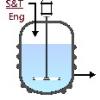I am trying to simulate a packed distillation column using the RadFrac block. I want to model the separation using NRTL, a Rate-based distillation model, and specified structured packing. Many of the compounds I am trying to model are not in any Aspen databases and have been User Defined. To run the Rate-based distillation model, Aspen requires vapor and liquid viscosity. I have managed to estimate the viscosity for all my compounds and fitted them to the DIPPR model (DIPPR Equations 101 and 102). However, the model requires an estimation for the mixture viscosity to simulate the separation. I do not have model parameters for any of the mixture models (Chapman-Enskog-Brokaw-Wilke, Chung-Lee-Starling, TRAPP, Lucas, etc.). I would prefer to approximate the mixture viscosity by using a mole fraction weighted average (Sum[yi*visci]). A model such as this does not seem to exist in Aspen for vapor mixture viscosity.
Does anyone have any suggestions to get around this issue? I know it's possible to write my own mixing rules, but I'm not sure I will be able to install a Fortran compiler on my computer as it has restricted access. If this is possible to accomplish using Excel, that might be an option. Any insight is greatly appreciated. Thanks!

 FB
FB









